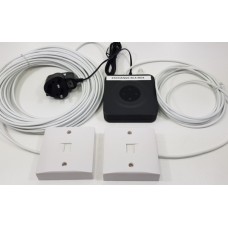Exchange in a BOX Questions
Our Exchange in a Box solutions will work with both modern brand new land line push button (tone dialling) telephones and vintage (1930's to 1980's) pulse dial telephones.
Vintage telephones use a method of dialling out called "pulse dialling". Pulse dialling is supported by our Exchange in a Box solutions.
Please be aware that rotary dials are mechanical devices that require servicing and calibration every twenty to thirty years. We cant be responsible for poor calibration of your vintage telephone if you have bought it elsewhere.
We have been interested in land line telephones for over 40 years and even in the 1970's were interested in having a simple system to dial and speak between two telephones without the need for a land line.
Over the years we found various large complicated and/or expensive solutions however even these often had American ringing and tones. So a few years ago we decided to develop our own simple to use (and easy to setup) cost effective solution.
Our solution is a very cost efficient plug and play unit that requires no user setup, you just turn it on and use it.
It provides UK tones and that unique classic British telephone ring.
As the expression goes a picture is worth a thousand words, well a video is even better. So the best way to answer this question is to watch our video of it in use. Our Videos
A longer more detailed video is also available lower down that page showing you how to set it up.
We have configured Exchange in a Box with a few different telephone numbers.
0: Simplest unforgettable quick option for starting the call from off stage etc
41: Simple 2 digit number (simulates 1930's era outgoing call)
1212: The old "New Scotland Yard" in Whitehall London.
3131: Easy to remember 4 digit number (see it in use herehttps://www.youtube.com/watch?v=yuOKKg3izKQ)
654321: Six digit 1960's onwards outgoing call
We are a family business and our lead technician has over 32 years experience working for BT with 5 years worth of qualifications in Telecommunications.
Our chief engineer also quality checks every unit upon completion before they leave our workshop. We pride ourselves that you will not find better workmanship elsewhere.
All our units come with a twelve month guarantee, see our terms and conditions for details.
The main aim of developing these Exchange in a Box solutions was to make them VERY simple plug and play, so as part of that all the very complex configuration is done in our workshop.
Therefore it is not possible to add your own telephone numbers or program your exchange in a box yourself,
however we are able to change the default number while we are building your unit so please ask us about this service.
If you have problems dialling make sure you have waited the two minutes (start-up time) and check then that it works first with a modern push button (MF) telephone.
If any of your vintage “pulse dial telephones” do not work when dialling please check that they have the make/break ratio set correctly, ideally between 40% and 45% (This is vitally important for old pulse dial telephones) See our Adjustment video . Once this make to break calibration is confirmed please make sure the dial speed is set to just over 10 PPS (pulses per second). Provided the make/break ratio is correct these units should work reliably between 9.5 and 12 PPS.
The UK uses a 3 wire internal telephone wiring system and a unique BT style plug, most of the rest of the world use a 2 wire system and many different styles of telephone plug. Consequently we do not sell or post these Exchange in a Box units outside of the UK.
Plus by selling within the UK it makes us less likely targets for postal fraud etc.
The hardware is actually a standard piece of telephony hardware called an Analogue Telephone Adapter (ATA) normally used for VOIP. We flash it with different firmware and then configure the software (over 12 months of experimentation) to provide the functionality. We also build up the UK telephone leads in our workshop and test the whole end to end solution rigorously.
This use of mass produced commercial grade hardware for "ring generation", tones and speech etc makes the solution far more reliable than other home built electronic hardware solutions. For example the original ATA development teams will have spend many man years perfecting and testing these hardware devices for telephony for many thousands if not millions of end customers.
This use of commercial telephony hardware also means our units in turn are electrically safe and conform to CE regulations etc.
Exchange in a Box 1 : Telephone Intercom System
Telephone Intercom System (Stage Telephone Ringer). Dubbed "Exchange in a Box" This Plug and Play so..
£120.00

